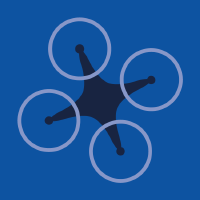Topic Menu
► Topic MenuTopic Editors





Unmanned Ground and Aerial Vehicles (UGVs-UAVs) for Digital Farming

Topic Information
Dear Colleagues,
New projections of escalating population growth around the planet come as the world faces major global challenges such as climate change, environmental degradation, and food insecurity. Digital farming based on sustainable agricultural practices will potentially overcome the above challenges, simultaneously increasing crop yield while reducing farming inputs.
Over the last decade, unmanned ground and aerial vehicles (UGVs-UAVs) have become a significant tool for digital farming, providing real-time precisely located and scalable data.
This Topic aims to keep up with progress on the latest applications derived from the use of unmanned ground and aerial vehicles (UGVs-UAVs) within the digital farming framework, including the evolution of integrating precision crop management systems and smart operations, as well as pointing out the challenges still ahead.
At the same time, this Topic also relies on the CHAMELEON Project (https://chameleon-heu.eu/about/). The CHAMELEON Project (flyer can be downloaded) activities have set ambitious targets to address a common challenge among EU countries: to support key areas such as agriculture, forestry, livestock, and rural development towards their conversion to sustainable and digital sectors, through the development of an integrated network of collaborating agents, equipped with advanced sensing and cognitive capabilities that can support multiple missions at tactical level. As a result, CHAMELEON will develop a Drone Innovation Platform and support the digital transformation of the agriculture, forestry, and livestock sectors in Europe.
Novel improvements in both methodologies with advanced data and analytic algorithms and techniques that accomplish management operations in an autonomous way from drones are welcome.
Dr. Monica Herrero-Huerta
Dr. Jose A. Jiménez-Berni
Dr. Shangpeng Sun
Dr. Ittai Herrmann
Prof. Dr. Diego González-Aguilera
Topic Editors
Keywords
- UAVs and UGVs
- precision agriculture
- smart farming
- internet of things
- artificial intelligence
- computer vision
- proximal and close sensing
- integrated sensing
- precision crop management
Participating Journals
| Journal Name | Impact Factor | CiteScore | Launched Year | First Decision (median) | APC |
|---|---|---|---|---|---|

Agriculture
|
3.6 | 3.6 | 2011 | 17.7 Days | CHF 2600 |

Applied Sciences
|
2.7 | 4.5 | 2011 | 16.9 Days | CHF 2400 |

Drones
|
4.8 | 6.1 | 2017 | 17.9 Days | CHF 2600 |

Remote Sensing
|
5.0 | 7.9 | 2009 | 23 Days | CHF 2700 |

Sensors
|
3.9 | 6.8 | 2001 | 17 Days | CHF 2600 |

MDPI Topics is cooperating with Preprints.org and has built a direct connection between MDPI journals and Preprints.org. Authors are encouraged to enjoy the benefits by posting a preprint at Preprints.org prior to publication:
- Immediately share your ideas ahead of publication and establish your research priority;
- Protect your idea from being stolen with this time-stamped preprint article;
- Enhance the exposure and impact of your research;
- Receive feedback from your peers in advance;
- Have it indexed in Web of Science (Preprint Citation Index), Google Scholar, Crossref, SHARE, PrePubMed, Scilit and Europe PMC.

